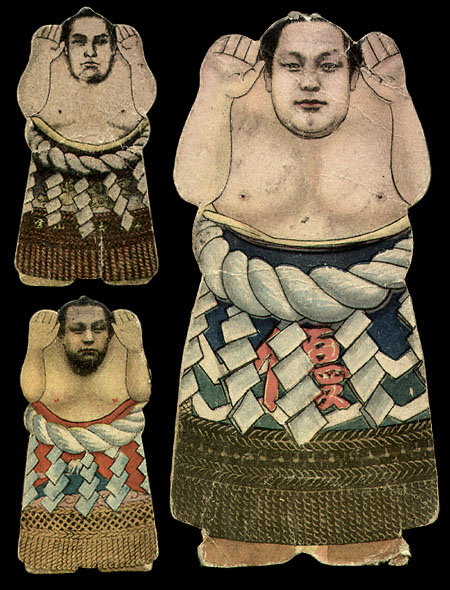Here we'll talk about the more common M-series menko, or Square series, which are
the most traditional, most common and most affordable series of menko. In fact, almost half of the approximately 340
individual type of sumo menko are classified as M-series menko.
The first part
of the paper sumo menko era from the late 1800s to the 1930s was dominated by
the R-series and C-series of menko and relatively small amount of M-series
menko were printed. In fact, there were
only about seven M-series sets produced during this time compared to about the
50 or so total sets manufactured during the same time period. The very first menko set, the1860 Kesho
Mawashi Set (M1860), is debatable on whether or not it is a true menko set (See
Picture 1). There were several games
with woodblock printed sheets of rikishi that were meant to be cut out and
played with, but the timeframe from which they were made doesn’t quite line up
for when paper sumo menko started getting printed. Regardless, this “first” set is a true piece
of history and an example is seen below.
Picture 1 (M1860 Set) – First known M-series
Set, woodblock printed menko of generic rikishi
The real boom of
M-series menko started right before World War II and continued to 1959 when it
was rapidly replaced by the more popular bromides of the era. One of the most historically significant
menko sets ever produced was from November 1942. The 1942 Nagoya Gunbai Set (M421) made by
Nagoya Gangu was the only set ever printed during the middle of World War II
(See Picture 2). At this point in the
war, Japan
had been fighting with China
for 10 years and had entered war with America a year earlier in
1941. Japan was short on many basic necessities
including food, oil and paper so it was almost unheard of to print and sell “frivolous”
items such as menko and games and people were expected to support the war by
giving up some of the comforts of life and making daily sacrifices. Consequently, there wasn’t extra money to
spend on items such as menko even if they had printed them in great quantity. What makes M421 an even more intriguing set
is that it came in 5 variations and completing any one of the variation sets is
difficult, let alone completing the master set of all 5 variation sets.
Picture 2 (M421-4 Set) – Future
Yokozuna Maedayama as an Ozeki
After World War II, it
took several years for Japan
to recover economically and menko production followed suit. It wasn’t until 1953, when a fourth sumo
tournament was added to the schedule, a new stadium was on the verge of opening
and bouts were being televised nationally, that sumo and sumo menko regained
their popularity. The most significant
set printed during this time was the 1951 Sanenchu 5 Set (M511). Please see my SFM October 2008 sumo menko article
here
for more information on this set. The M511
set (See Picture 3) contains at least 7 of the modern-day yokozuna as well as 2
of the modern day ozeki, but I’m predicting there is a yet to be discovered
menko of Sekiwake Tochinishiki lurking out there somewhere. I’m also predicting menko of future Ozeki Saganohana,
Kotogahama, Matsunobori and Ouchiyama. If
these are all confirmed, it would mean there are 8 yokozuna and 6 ozeki in this
single set making it one of the most important sets in sumo menko history!
Picture 3 (M511-2 Set) – Future
Yokozuna Chiyonoyama as an Ozeki
Sumo menko production peaked in 1956 as well as the
number of M-series sets produced per year.
The majority of M-series sets during this time started to look this same
and the increasing popularity of the BB-series and BC-series menko led to a
phase-out of the M-series by the 1960 even though the end of the sumo menko era
continued for another 4 years. One set
that stands out from all these sets is the 1956 Tsuriyane 7-8-9 set (See Picture 4) which
attempted to miniaturize menko. This set
is approximately 66% smaller that the typical M-series sets and contained
Future Yokozuna Wakanohana’s first ever menko as an ozeki. Evidently this new size didn’t catch on as
the standard size continued to be 1.25” x 2.75” for the next four years.
Picture 4 (M5616-1 Set) – Future
Yokozuna Wakanohana as an Ozeki
The last M-series menko was
printed in late 1959 or early 1960.
Although the exact date is unknown, the 1960 Trump 7-8 Set (M601) is
considered the last sumo M-series menko set ever printed (See Picture 5). It is a basic set with a playing card back
and only the shikona is printed on the front to identify the rikishi. The colors are nice and vivid, but the more
popular bromides of the day made the M-series “old” news.
Picture 5 (M601 Set) – Ozeki
Kotogahama
Because of the number of M-series
sets printed, they are some of the most affordable sumo menko sets out
there. In addition, many M-series menko that
survive today are in great shape because of their thicker cardboard which
withstood more menko battles. Most of the
1950s M-series menko can be purchased for $1.00 - $1.50 per menko and they are
almost always available for auction.











No comments:
Post a Comment